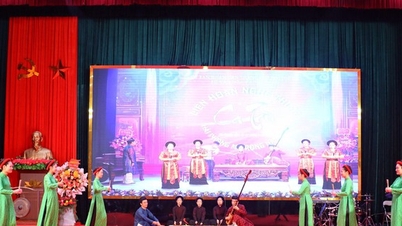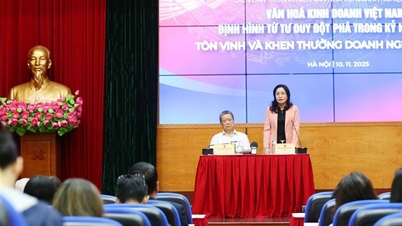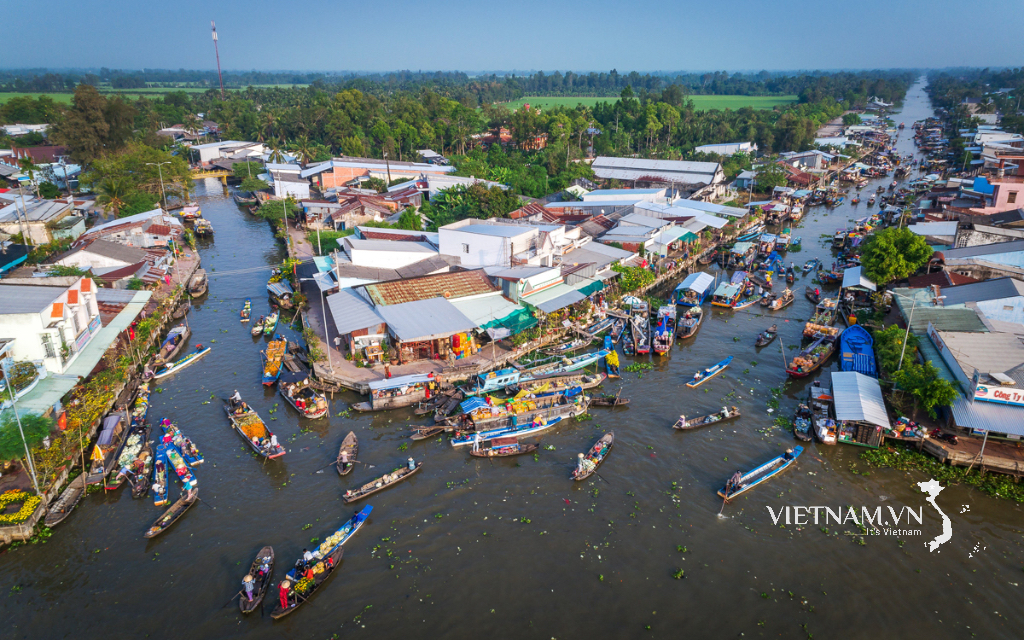Outstanding potential: "Living heritage" platform
Sa Pa National Tourist Area is one of the famous tourist destinations with over 120 years of formation and development. This tourist area was recognized by the Prime Minister under Decision No. 1927/QD-TTg dated December 1, 2017. The scope of Sa Pa National Tourist Area includes all administrative units of Sa Pa district/town (formerly), and is connected to Bat Xat district (formerly) of Lao Cai province.
Sa Pa National Tourist Area possesses an outstanding resource base, which is a solid foundation for tourism development orientation associated with profound experiences. Sa Pa is not only famous for its natural beauty but also for its unique cultural and ecological foundation.
Located at an average altitude of 1,200 - 1,800m, Sa Pa National Tourist Area has a fresh, cool climate with European nuances, converging four seasons in one day. This is an ideal resort in the summer and a unique place to explore snow in the winter. Sa Pa landscape is characterized by 4 national-level scenic relics (Ta Phin Cave, Ham Rong Mountain, Terraced Fields and Ancient Stone Carving Area). In particular, Hoang Lien National Park is one of the first 4 ASEAN Heritage Parks recognized in Vietnam, bringing ecological value and an ideal setting for exploration activities.

Sa Pa National Tourist Area possesses an outstanding resource foundation, which is a solid foundation for tourism development orientation associated with profound experiences.
However, it is the colorful cultural treasure of six ethnic groups (Mong, Dao, Tay, Kinh, Giay, Xa Pho) living through many generations that is the core difference, turning Sa Pa into an attractive "living heritage".
In fact, linking tourism with culture is a global strategic trend. The needs of modern tourists are oriented towards authentic cultural experiences. Sa Pa National Tourist Area has all the conditions to become a mountainous tourism center with a strong cultural identity.
In that context, Associate Professor Dr. Pham Trung Luong, former Deputy Director of the Institute for Tourism Development Research, deeply analyzed the value that the unique resources of mountainous areas can bring: "The values of natural tourism resources, especially the climate, landscape and culture with unique characteristics of mountainous areas, are great potentials to develop mountain tourism into an important economic sector, a sustainable output for agricultural products and contribute to creating many jobs for mountainous communities that still face many difficulties."
MSc. Hoang Thi Vuong - Head of the Community Connecting Cultural Cooperative (CCC Co.op) affirmed: "Sa Pa National Tourist Area, with its rare natural and cultural advantages, is a typical case to demonstrate the ability to harmoniously combine high mountain resorts and ethnic cultural experiences, thereby bringing added value to tourism and sustainable livelihoods for the local community."
Deployment model: Community is the subject of authentic experience
To promote this potential, Sa Pa has strongly transformed, focusing on developing experiential tourism and taking the community as the main subject through the Tourism Cooperative model.
The transformation is evident in the formation of key community tourism destinations: Ta Van (Giay), Ta Phin (Red Dao), Muong Hoa (Mong), Ban Ho (Tay), and Nam Sang village (Xa Pho). Here, visitors are invited to become part of local life and have the opportunity to participate in immersive tours such as "A day as a Mong bride" or explore traditional craft villages. These products are not just simple services but a genuine cultural sharing.

The colorful cultural treasure of six ethnic groups (Mong, Dao, Tay, Kinh, Giay, Xa Pho) living through many generations turns Sa Pa into an attractive "living heritage".
At the same time, the role of tourism cooperatives is essential in ensuring the authenticity and sustainability of the experience. Cooperatives help people manage homestays according to standards, standardize service processes and encourage the model of "1 household - 2 livelihoods" (agriculture & tourism). Thanks to cooperatives, indigenous knowledge and festivals (Gau Tao Festival, Tet Nhay) are organized on a large scale, turning culture into quality-controlled economic products.
Regarding accommodation and activities, visitors will stay at homestays managed by local households, live with the locals and participate in the daily work of the ethnic groups. Visitors will also participate in role-playing experiences. These tours are designed for visitors to actually participate in cultural life, combine trekking, explore terraced fields and learn about local knowledge about herbs and farming. Regarding handicraft and culinary heritage, visitors can visit traditional craft villages (brocade weaving, weaving, silver carving) and enjoy typical dishes such as thang co, armpit pork...

Tourists can visit traditional craft villages.
In particular, the "Medicinal Dishes" (Dia Nhan) of the Red Dao people are a precious heritage, which is being researched to be included in the official menu. In addition, ethnic exchange activities and traditional festivals such as the Gau Tao Festival (Mong), the Cap Sac ceremony (Red Dao), and the Xoe festival (Tay) have become events that attract tourists. In addition, Sa Pa has begun to include live performances such as "Sa Pa quietly loves - The Mong Show" to create new highlights for visitors to experience.
One of the typical examples of this professionalization effort is the Community Culture Connect Cooperative (CCC Co.op). This model focuses on connecting and supporting ethnic minority members in providing tourism services in a professional and controlled manner.
The cooperative has helped households: Standardize service quality (such as homestay, cuisine...). Apply digital technology (using QR codes, promoting on social networking platforms...) to reach a wider market. Preserve and exploit traditional crafts (brocade weaving, indigo dyeing...) effectively, creating stable output for handicraft products...
In addition, it is impossible not to mention Ta Phin Community Tourism Cooperative. This model is a clear demonstration of a sustainable development strategy when harmoniously combining traditional farming and experiential tourism. The cooperative not only organizes trekking tours and provides quality accommodation services, but also takes on the responsibility of preserving farming methods on terraced fields. This model has successfully transformed the intangible cultural heritage of ethnic minorities into a unique tourism product, helping visitors gain a deeper understanding of the agricultural life cycle and creating a stable source of income for members.
Thanks to this linkage, indigenous knowledge and cultural values are not only preserved but also create sustainable livelihoods and enhance the position of people in the tourism supply chain.

In Sapa, live performances have also begun to be introduced to create new highlights for tourists to experience.
Challenges and directions for sustainable development
Despite significant strides, Sa Pa still faces challenges that threaten the authenticity of its cultural experience.
The biggest problem is the risk of over-commercialization. MSc. Nguyen Thi Phuong Lan (Vietnam Institute of Culture, Arts, Sports and Tourism) pointed out: "When mountain tourism develops strongly, market demand often tends towards "cultural specialty" experiences. This leads to a situation where some communities tend to over-commercialize traditional cultural values.
Many festivals, customs, dances, and folk songs are "staged" to serve tourists. For example, many places organize performances of xoe dance, khen dance, or Gau Tao festival according to the schedule to serve tourists, not according to the rhythm of the local culture. This causes the identity to be distorted, losing its inherent sacredness. Over time, the community itself also forgets the original meaning of the heritage, only remembering the "tourist" version.

Spontaneous construction, concreting and loose planning are destroying the landscape, reducing the value of the tourist experience.
In addition, challenges in planning and management still exist. Many high-end accommodation establishments have not systematically integrated local culture, and their experiential products are still rudimentary. More worryingly, spontaneous construction, concreting and loose planning are destroying the landscape, reducing the value of authentic experiences.
Associate Professor Dr. Pham Hong Long (Faculty of Tourism, University of Social Sciences and Humanities, VNU) analyzed: "The attractiveness of Sa Pa, after the completion of the Hanoi - Lao Cai highway and the Fansipan cable car system, has opened an era of explosive growth. The initial success of the community tourism model (homestay) has quickly attracted a wave of massive investment in large-scale hotels and resorts."

Developing Sa Pa tourism associated with authentic cultural experiences is the optimal path for sustainable development.
He highlighted three core challenges: First, economically, profits are unevenly distributed, with the majority falling into the hands of outside investors, while local people are mainly engaged in precarious economic activities such as street vending; Second, environmentally, Sa Pa faces serious pollution due to waste, untreated wastewater, along with deforestation and landslides due to rampant construction; Third, excessive commercialization has given rise to the phenomenon of "cultural staging, cultural commercialization", causing traditional customs to be transformed to serve tourists, leading to the erosion of authentic cultural identity.
Culture is a commitment to sustainable development
Therefore, to ensure authenticity and sustainability, Sa Pa needs to focus on the following strategic solutions:
Firstly, strengthen construction management, strictly limit concreting and encourage green architecture, use of indigenous materials. Secondly, officially position Sa Pa as "The Capital of Authentic Cultural Experiences in Southeast Asia". At the same time, link the region with Mu Cang Chai, Ha Giang to create a chain of experiential Northwest products. Finally, it is necessary to continue investing in tourism cooperatives and providing in-depth training for local people to improve service quality and preserve indigenous knowledge professionally.
Developing Sa Pa tourism associated with authentic cultural experiences is the optimal path for sustainable development. It is a collective commitment, in which the community is the subject and the direct beneficiary of the preservation of its own heritage./.
Source: https://bvhttdl.gov.vn/phat-trien-du-lich-sa-pa-gan-lien-voi-trai-nghiem-van-hoa-ban-dia-20251110230911044.htm

























![[Photo] Prime Minister Pham Minh Chinh attends the annual Vietnam Business Forum](https://vphoto.vietnam.vn/thumb/1200x675/vietnam/resource/IMAGE/2025/11/10/1762780307172_dsc-1710-jpg.webp)



























































![Dong Nai OCOP transformation: [Article 4] Reaching national standard products](https://vphoto.vietnam.vn/thumb/402x226/vietnam/resource/IMAGE/2025/11/11/1762825820379_4702-cac-san-pham-trai-cay-chung-nhan-ocop-nongnghiep-174649.jpeg)



![Dong Nai OCOP transition: [Article 3] Linking tourism with OCOP product consumption](https://vphoto.vietnam.vn/thumb/402x226/vietnam/resource/IMAGE/2025/11/10/1762739199309_1324-2740-7_n-162543_981.jpeg)







Comment (0)